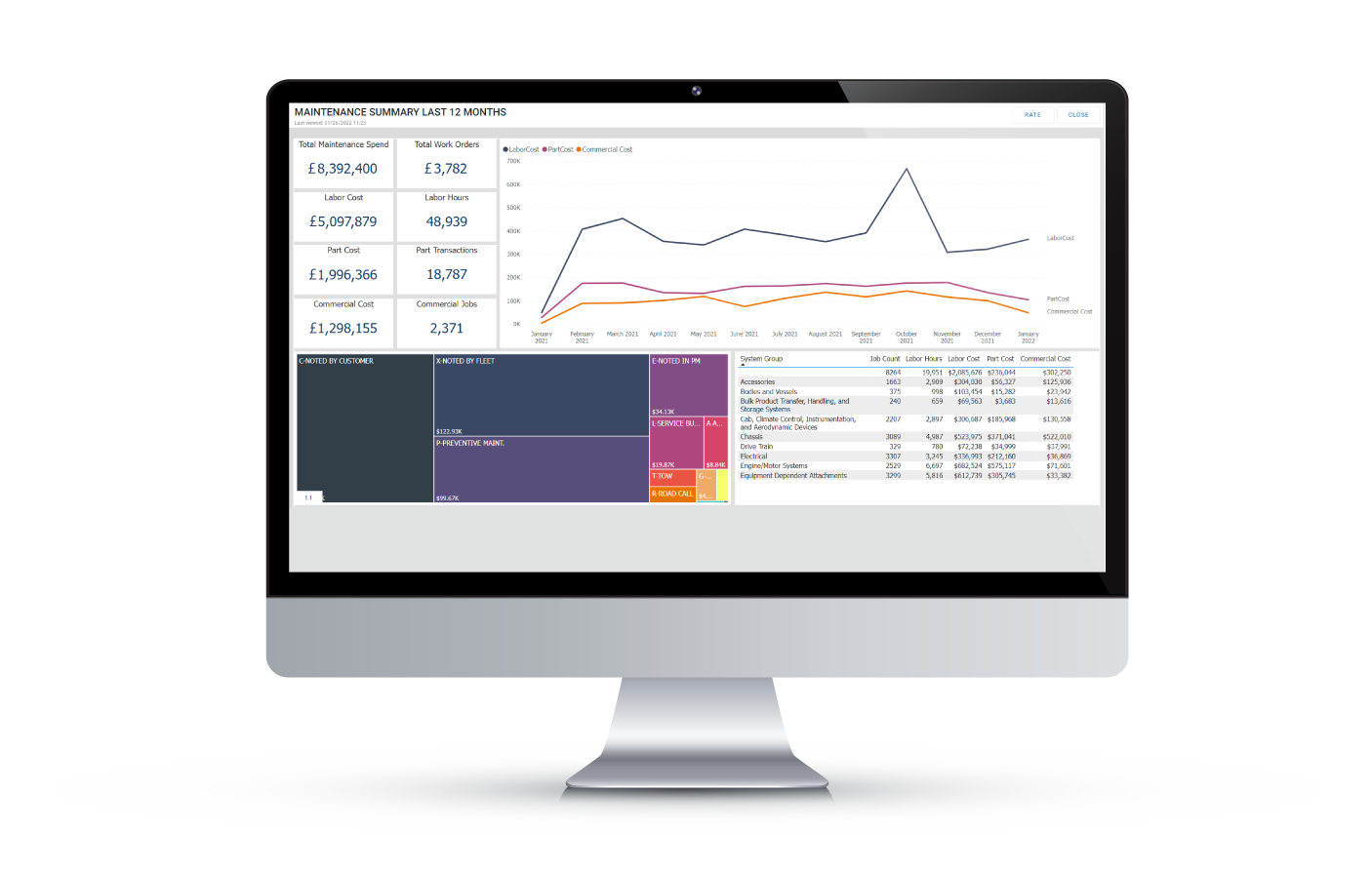Trend forecasting involves researching and developing data-backed predictions for different industries. There have been many documented trends throughout the fleet industry’s history, from the inception of barcoding on the shop floor to the integrated fleet and fuel management systems of today.
AssetWorks has served the fleet management industry for over 40 years. Our team has seen many changes in the industry, from long-term, cultural shifts to short-term fixes. In this post, our team outlines the top forecasted trends for 2023 and what your fleet can do to keep up with these trends.
Predictive Analytics Becomes an Insightful Resource
In 2023, the fleet industry is expected to witness significant advancements in predictive analytics within fleet management software. These trends are likely to shape the way companies optimise their operations and enhance overall efficiency. Here’s a short summary of the predictive analytics trends anticipated in the fleet industry for 2023:
Predictive Maintenance: Fleet management software will increasingly leverage predictive analytics to identify and address maintenance needs before they result in vehicle breakdowns. By analyzing historical data, real-time diagnostics, and sensor inputs, the software will predict potential maintenance issues, enabling proactive maintenance scheduling and reducing costly downtime.
Fuel Efficiency Optimisation: Predictive analytics will play a crucial role in optimising fuel consumption. Fleet management software will analyse various factors, including vehicle performance data, driver behaviour, traffic conditions, and weather patterns, to provide actionable insights. These insights will empower fleet managers to make informed decisions, such as route planning, driver training, and vehicle selection, to improve fuel efficiency and reduce costs.
Driver Performance Analytics: Fleet management software will increasingly focus on analysing driver behaviour and performance using predictive analytics. By combining data from telematics, GPS, and other sources, the software will generate driver performance profiles, identifying areas for improvement and training needs. This approach will promote safer driving habits, reduce accidents, and enhance overall fleet safety.
Demand Forecasting: Predictive analytics will assist fleet managers in accurately forecasting demand for transportation services. By analysing historical data, market trends, seasonal patterns, and other relevant factors, the software will provide insights into demand fluctuations. This information will enable fleet operators to optimise resource allocation, adjust staffing levels, and improve customer satisfaction by meeting service demands more effectively.
Route Optimisation: Fleet management software will leverage predictive analytics to optimise route planning. By considering real-time and historical data, such as traffic conditions, weather forecasts, delivery schedules, and vehicle capabilities, the software will suggest the most efficient routes for each trip. This will result in reduced fuel consumption, improved on-time delivery rates, and enhanced productivity.

Electric Vehicle Management is Still a Key Priority for Fleets
With additional mandates and sanctions for electric vehicle adoption in 2022, fleet electrification is a top goal for most fleets across Europe and North America. For fleets already on the journey to fleet electrification, they will learn that investing in EVs is only the beginning. There will need to be significant infrastructure updates to accommodate for EV charging stations, which can take months to fully implement. For fleets to be successful with their electric operations in 2022, they need to:
- Define goals and ideal timeline
- Build fleet profile and replacement forecast
- Match needs to availability
- Build TCO and CO2 models
- Develop plan for charging infrastructure
- Assess available credits and rebates
- Consider short-term alternatives

EV Data Integration Becomes Essential
Electric Vehicle (EV) Integration is a significant trend in fleet management as more organisations are embracing sustainable transportation solutions. Fleet management software is evolving to accommodate the unique requirements of electric fleets. Here are some key aspects of this trend:
Monitoring Charging Infrastructure: Fleet management software will include features to monitor charging infrastructure. It will provide real-time information on the status of charging stations, availability, and utilisation rates. This helps fleet operators plan routes and ensure vehicles have access to charging points, minimizing downtime and optimising charging efficiency.
Optimizing Charging Schedules: Electric fleet management software will enable fleet operators to optimise charging schedules based on factors such as energy costs, vehicle usage patterns, and battery capacities. By analysing data, the software can determine the most cost-effective and efficient times for charging, ensuring vehicles are ready for operation when needed while minimising energy expenses.
Battery Range and Performance Insights: Fleet management software will provide detailed insights into battery range and performance for each electric vehicle in the fleet. It can track factors such as state of charge, battery degradation, and real-time energy consumption. These insights help fleet managers understand vehicle range limitations, identify underperforming batteries, and plan routes accordingly.
Charging Infrastructure Expansion: As the adoption of electric vehicles grows, fleet management software will support the expansion of charging infrastructure. It can provide insights into the ideal locations for charging stations based on fleet routes, energy demand, and charging patterns. This data-driven approach helps fleet operators make informed decisions about installing and expanding charging infrastructure to support their electric fleets effectively.

Cyberattacks Forcing Fleets to Re-examine Data Security
2021/2 was a record year for cyberattacks. According to Check Point Research, these attacks increased by 50% on a week-by-week basis in 2021. While encryptions, employee security training, and strict organisational protocols may protect a fleet against most cyberattacks, organisations need to focus on data security more than ever to remain protected. To combat these threats, more fleets are turning towards hosting their fleet and asset management data with their software provider. Most software providers must adhere to set governmental standards for data security, resulting in increased security and system uptime.

Driver & Technician Shortages Impacting Both Private and Public Sectors
The driver and technician shortages are not new, but challenges stemming from the COVID-19 pandemic has brought both issues into the spotlight.
With supply chain disruptions heavily impacting the logistics industry, an increased demand for drivers has sent the industry into crisis mode. There simply aren’t enough truck drivers to meet the demand. In a research study by Coyote, the main challenges outlined include:
- Younger drivers not entering the industry, with only 20% of the workforce under age 45
- Competition from warehousing jobs, with approximately 62% of warehousing jobs filled by people under age 45
- Job postings requiring more experience, leading to a skill gap in candidates
For technicians, similar challenges apply. As experienced technicians reach retirement age, there are fewer and fewer technicians ready to take their place on the shop floor. Some reported reasons behind the shortage include:
- Technology on the shop floor doesn’t entice younger technicians, who are comfortable using smart phones and tablets instead of sharing a desktop or filling out paper forms
- There are not enough career advancement opportunities. This could be addressed through the creation of an employee development plan, access to certifications or training courses, and job shadowing

Increased Data Means Increased Need for Advanced Business Intelligence
In 2023, fleets are collecting more data than ever before. Vehicles, software, hardware, and personnel all create data, which needs to be scrubbed and consolidated for optimal reporting and analyses.
With advanced business intelligence features fleets can more easily:
- Rightsize their fleet vehicle count
- Better understand asset optimisation
- Identify areas of over- or under-spending
- Integrate data from fleet, fuel, EV, and GPS systems
Increased Costs Causing Fleets to Postpone Vehicle Replacements
Since the beginning of the COVID-19 pandemic, fleet costs across the board have increased. These increases are due to multiple factors, like supply chain disruptions, inflation, and other market forces.
- Fuel prices– Fuel prices, while always fluctuating, will likely remain elevated throughout 2023
- Vehicle acquisition costs– Across the automotive and fleet industries, it costs more than ever for an organisation to acquire new vehicles due to increased demand and decreased inventory
- Preventive maintenance (PM)– The demand for synthetic motor oil led to increased scheduled maintenance costs for fleet organizations.
- Tire costs– While tire costs have been increasing over the past three years, they reached a 5% increase in 2021. After overall low fleet mileage in 2020, the sharp rise in 2021 and beyond led to increased demand and cost for tires and their components, like crude oil, rubber, and steel.
Even if costs continue to fluctuate in 2022, fleets can expect the lingering effects of cost increases to impact their operations. Many fleets have had to reexamine their vehicle replacement plans, since the market conditions impact the value of their vehicles and ability to procure replacement vehicles.

Telematics Tracking is More Important Than Ever
While Telematics isn’t new for the fleet industry, there is a demonstrated increase in Telematics software functionality that positively benefits fleets today, especially regarding driver safety. With technology becoming more intelligent, fleets will be able to benefit from features like:
- Geofencing
- Asset and driver scorecards
- Heat maps
- Analytics and reporting
Lightbulb Analytics, AssetWorks’ newest acquisition, are one the UK’s leading providers of telematics driven data analytics. Lightbulb Analytics’ analysis is utilised by a number of UK Police Forces and private sector businesses to ensure maximum efficiency and optimal performance of their fleet and personnel. Fleets will be looking to improve their operations through the use of telematics this year as integrated solutions are now on the market.
The fleet management industry is in a constant state of evolution. In 2022, fleets can expect many changes to strategy, operations, and technology—but it will be nothing they cannot handle if they prepare accordingly.












